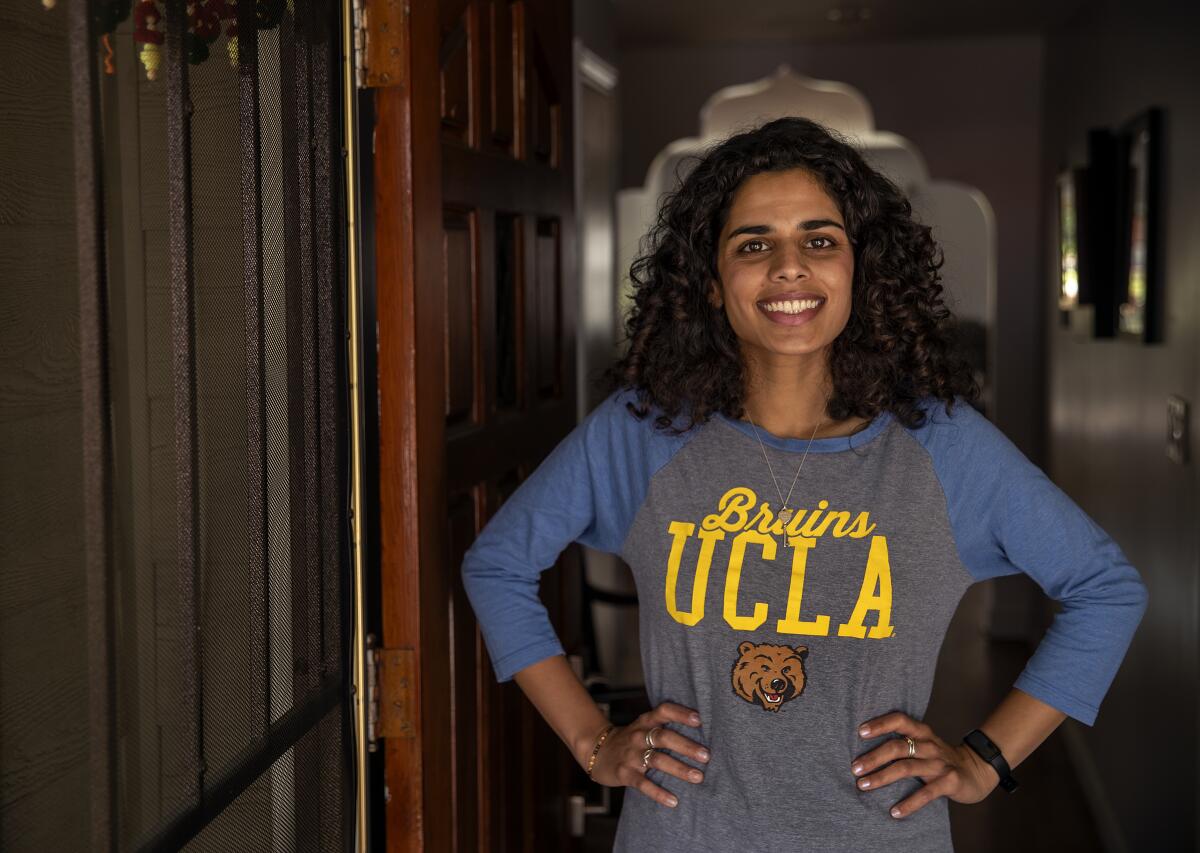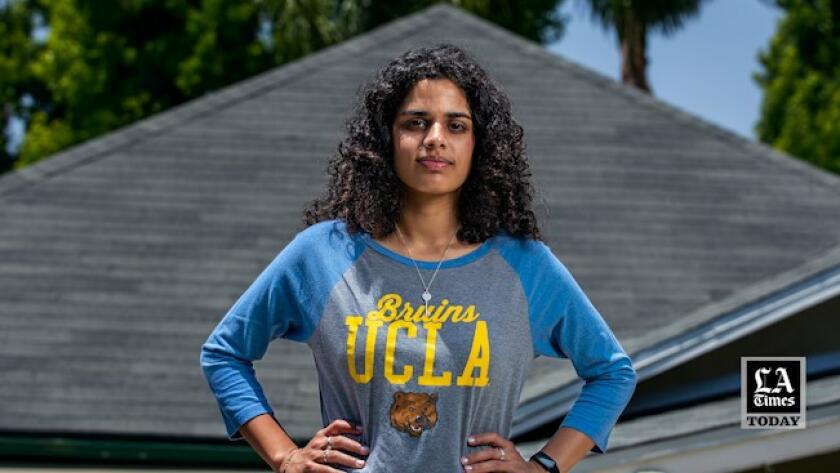Gen Z students want better mental health care access on campus

- Share via
When Meera Varma was in high school, she felt like a black cloud followed her everywhere she went.
Her struggles with mental health were difficult to explain to family members in their mother tongue, Hindi. Although they were supportive, she needed professional help. She found it in her school counselors, whom she saw almost daily as a senior.
After suffering frequent panic attacks in class, she started advocating at school district meetings for mental health services to be made a priority.
“I felt really isolated, and I didn’t want anyone to ever feel like I did,” Varma, 21, said.
Varma continued that activism after enrolling at UCLA, where she joined Active Minds, an organization whose mission is to change the conversation on mental health among college students. In recent years, that conversation has grown louder.
The two years of the COVID-19 pandemic have touched nearly everyone’s lives in some way, but members of Gen Z have been hit particularly hard. Loss of normalcy and routine during a time of immense development has contributed to increasing rates of mental illness in adolescents, said psychologist Tamika Damond, who runs a private practice, Believe Psychology Group.
Gen Zers have been more open about their struggles than members of older generations, a pattern that has meant rates of mental illness appear higher among young people. Members of Gen Z and millennials are also more likely to seek out mental health support than older generations, according to a recent survey by the American Psychological Assn.

For students of color, the last two years have brought additional burdens. The murder of George Floyd, police violence and anti-Asian hate crimes have amplified feelings of vulnerability that many students already experienced because of the pandemic, said April Clay, director of counseling services at Cal State L.A.
The result: a rising demand for mental health services on college campuses, which many schools are struggling to keep up with.
For decades, the supply of mental health professionals on college campuses nationwide hasn’t met the demand, according to data collected between 2013 and 2021.
One national organization that accredits counseling centers at many colleges and universities recommends one therapist for every 250 students, a standard many schools fail to meet.
Campuses with fewer counselors might end up with long waiting lists and offer only a limited number of sessions to students in an effort to spread resources among as many as possible.
“The mental health crisis has actually been happening for a number of years, building up to all of the racial trauma and the pandemic,” said Frances Diaz, director of the Counselor Center at UC Irvine. “And what we we’re seeing across the country is — university counseling centers in particular — now have demands that exceed the capacity to meet those demands.”
Many schools would need to nearly double their staff to meet the ratio the accrediting group recommends. Cal State L.A.’s counseling center, for example, employs 11 therapists — one for every 2,516 students — a staffing ratio that is actually better than that of many other campuses.
Schools rely heavily on money from the state and federal government to finance care.
The state’s three public college and university systems each use a different method for distributing mental health funds.
The California State University system allocates money based on the number of students on each campus eligible for federal Pell Grants. The University of California and the California Community Colleges distribute a set amount to each campus, then additional money dependent on enrollment, student demographics and needs.
A rough estimate based on student population shows that the UC system spends $56 per student on mental health care, CSU spends $31 per student and the community college system spends $14 per student.
Recently, the federal government started providing additional funds. Money from the CARES Act has allowed schools to start hiring more staff.
President Biden announced in his first State of the Union that the federal government would dedicate additional millions of dollars to bolster mental health resources across the country. Part of the money is slated for schools.
The state government has also increased support for mental health on campuses. Clay, of Cal State L.A., said her campus’ center hired two more counselors as a result of California’s Basic Needs Initiative and Student Mental Health Fund, which were adopted as part of the state’s 2021 budget.
The hope is that with smaller patient loads, staff won’t be stretched thin, and they’ll have the space to better meet students’ needs.
But hiring therapists can be a slow process.
Experts say that counseling on campuses, which was once part of retirement plans for older practitioners, has now become an entry-level position for newly graduated psychologists, who spend a few years on campus developing skills, then move on to other jobs, meaning schools have to deal with frequent staff turnover.
Students say they often encounter long waits and limited services.
- Share via
Watch L.A. Times Today at 7 p.m. on Spectrum News 1 on Channel 1 or live stream on the Spectrum News App. Palos Verdes Peninsula and Orange County viewers can watch on Cox Systems on channel 99.
When he began experiencing symptoms of depression, Gio Ibarra, 23, sought out mental health services at Cal State Fullerton. He had to wait two weeks for an intake appointment, but was eventually assigned a therapist.
He eventually switched to a therapist he found on his own. If he had continued using campus resources, he would have been restricted to 10 sessions each academic year because of appointment limitations.
During her time at Chapman University, Madison Hill, 26, also sought help on campus. By the time she received a response from the counseling center, weeks after her initial request, she had already found a therapist on her own.
Hill had been in therapy before college and was familiar with the process of reaching out. For someone who wasn’t, she said, waiting weeks for care could feel demoralizing.
“I wouldn’t have continued seeking help if I didn’t already know the system,” Hill said.
Mental health resources
Free and affordable services for Angelenos
Without a substantial influx of dollars and providers, there’s no way to meet every student’s needs, said Saimir Thano, director of the Peer Educator Program at UC Irvine. But he tries to fill in some of the gaps.
To stretch resources further, some universities have started peer programs in which students are trained to support one another.
Jessica Ortega, director of the COACH Program at UC Irvine, the university’s peer counseling program, said such efforts serve as a pipeline for students of color and LGBTQ students to get the support they need.
Eight years ago, Venecia Flores, 28, transferred to UC Irvine. She was a first-generation college student balancing academics and a part-time job. The stress began to weigh on her. But she didn’t know where to turn.
That’s when she found COACH.
Some days, her meetings with her mentor were just venting sessions. Other times, they focused on academic planning or finding other campus resources. She ultimately became a mentor herself.
She now works at UC Irvine as a financial aid counselor, but hopes to join the psychological services team.
“COACH shaped how I carry myself,” she said. “It really gave me the confidence to go into the world.”
Despite such efforts, program directors across the state agreed students still slip through the cracks.
Professors have had to serve as both educators and counselors in many cases. For Varma, it was one of her high school teachers who first noticed she was struggling — not the counselor.
Campus clubs and groups, including Active Minds, are also working to provide a safe place for students when counseling centers can’t.
“I saw it as an opportunity to really get involved with people like me who are passionate about mental health,” Varma said.
While schools scramble to meet current demands, Varma said, they also need to lay the groundwork of stable resources for years to come.
“With mental health, there’s always room to grow,” she said.
This article is part of The Times’ mental health initiative, For Your Mind, an effort to increase coverage around treatment, public policy, wellness and culture related to mental health in California’s communities.
If you or someone you know is suffering from thoughts of suicide, please call the National Suicide Prevention Lifeline at (800) 273-TALK (8255), or text the Crisis Text Line (text HELLO to 741741). Both services are free and available 24 hours a day, seven days a week. All calls are confidential.
Times multiplatform editing lead Rubaina Azhar contributed to this report.
More to Read
Sign up for Essential California
The most important California stories and recommendations in your inbox every morning.
You may occasionally receive promotional content from the Los Angeles Times.















